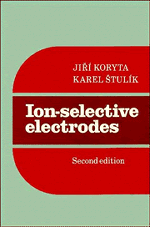Book contents
- Frontmatter
- Contents
- Preface
- 1 Introduction
- 2 The theory of membrane potentials
- 3 The theory of membrane potentials in ion-selective electrodes
- 4 Principal properties of ion-selective electrodes
- 5 Experimental techniques
- 6 Ion-selective electrodes with solid or glassy membranes
- 7 Ion-selective electrodes with liquid membranes
- 8 Potentiometric biosensors
- 9 Voltammetry at the interface of two immiscible electrolyte solutions
- Appendix
- Index
5 - Experimental techniques
Published online by Cambridge University Press: 05 November 2011
- Frontmatter
- Contents
- Preface
- 1 Introduction
- 2 The theory of membrane potentials
- 3 The theory of membrane potentials in ion-selective electrodes
- 4 Principal properties of ion-selective electrodes
- 5 Experimental techniques
- 6 Ion-selective electrodes with solid or glassy membranes
- 7 Ion-selective electrodes with liquid membranes
- 8 Potentiometric biosensors
- 9 Voltammetry at the interface of two immiscible electrolyte solutions
- Appendix
- Index
Summary
Measurement with ion-selective electrodes appears at first sight extremely simple and this is one of the main reasons for the great popularity of the method. However, to obtain meaningful results a number of conditions must be met, conditions which are sometimes contradictory and difficult to fulfil. A severe limitation is imposed on measurements with ISEs because of a fact inherent to most electrochemical methods: namely, that the measurement depends on heterogeneous reactions occurring at the electrode-solution interface. Consequently, the reproducibility and long-term constancy of the conditions at the interface is of paramount importance for accurate and reproducible measurements. There is no general solution to this problem and an ideal state can be approached more or less closely only by judicious selection of the experimental conditions, starting with the sample preparation, through the actual measurement, to the handling of the results. This is the main reason for the fact that of the extensive literature on ISEs, only a small part deals with real practical applications rather than with the laboratory study of the electrodes and methods, and that routine use of the ISEs in chemical analysis is less common than it would appear from the literature.
To attain satisfactory performance with most electrochemical methods, including potentiometry with ISEs in routine analytical work, a certain amount of information on electrochemistry and experimental experience is required. In this respect, electrochemical methods often compare unfavourably with spectral methods.
- Type
- Chapter
- Information
- Ion-Selective Electrodes , pp. 89 - 130Publisher: Cambridge University PressPrint publication year: 1983



